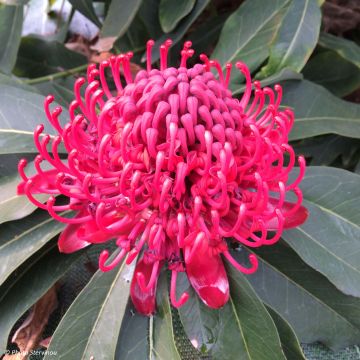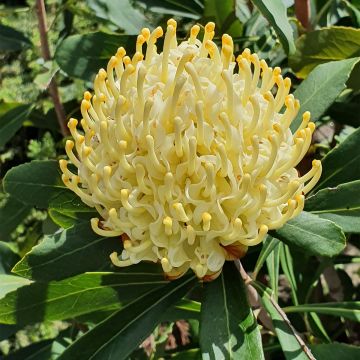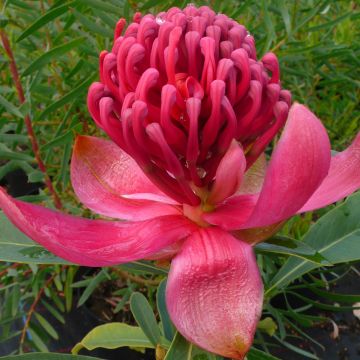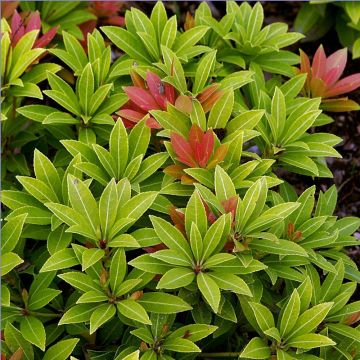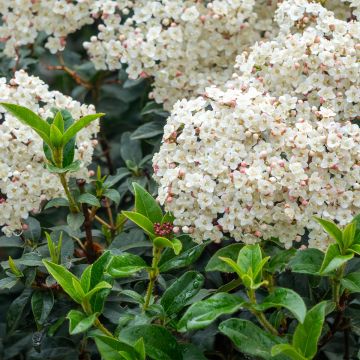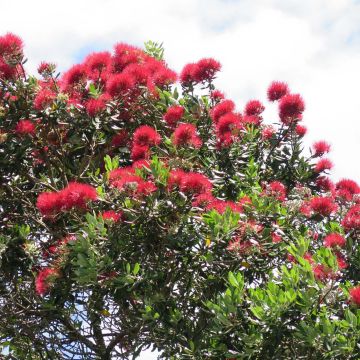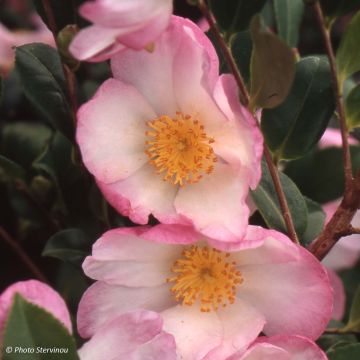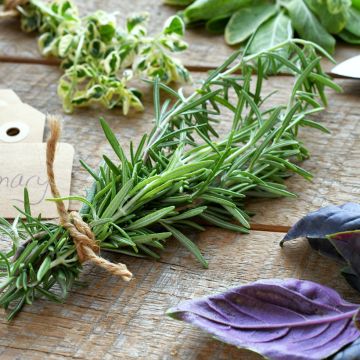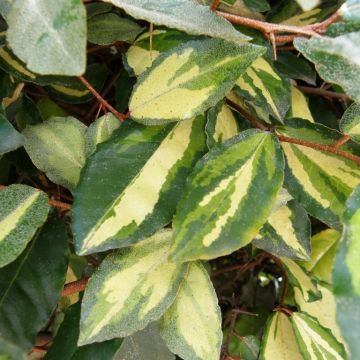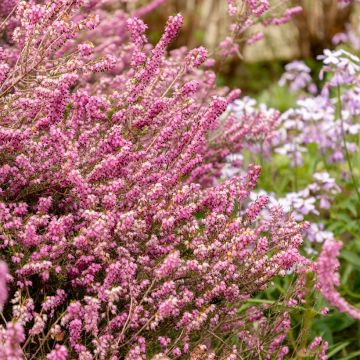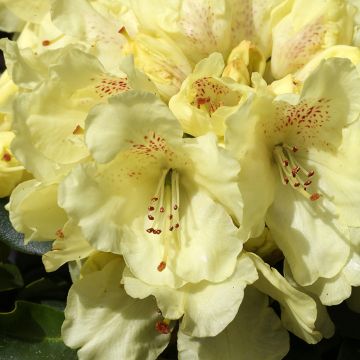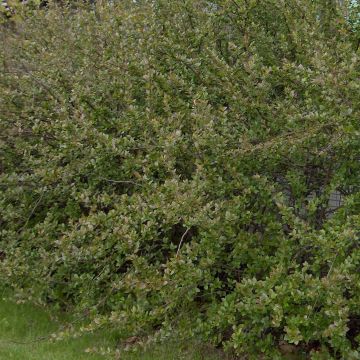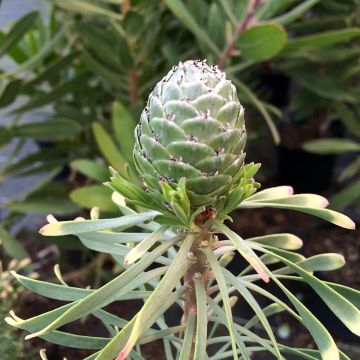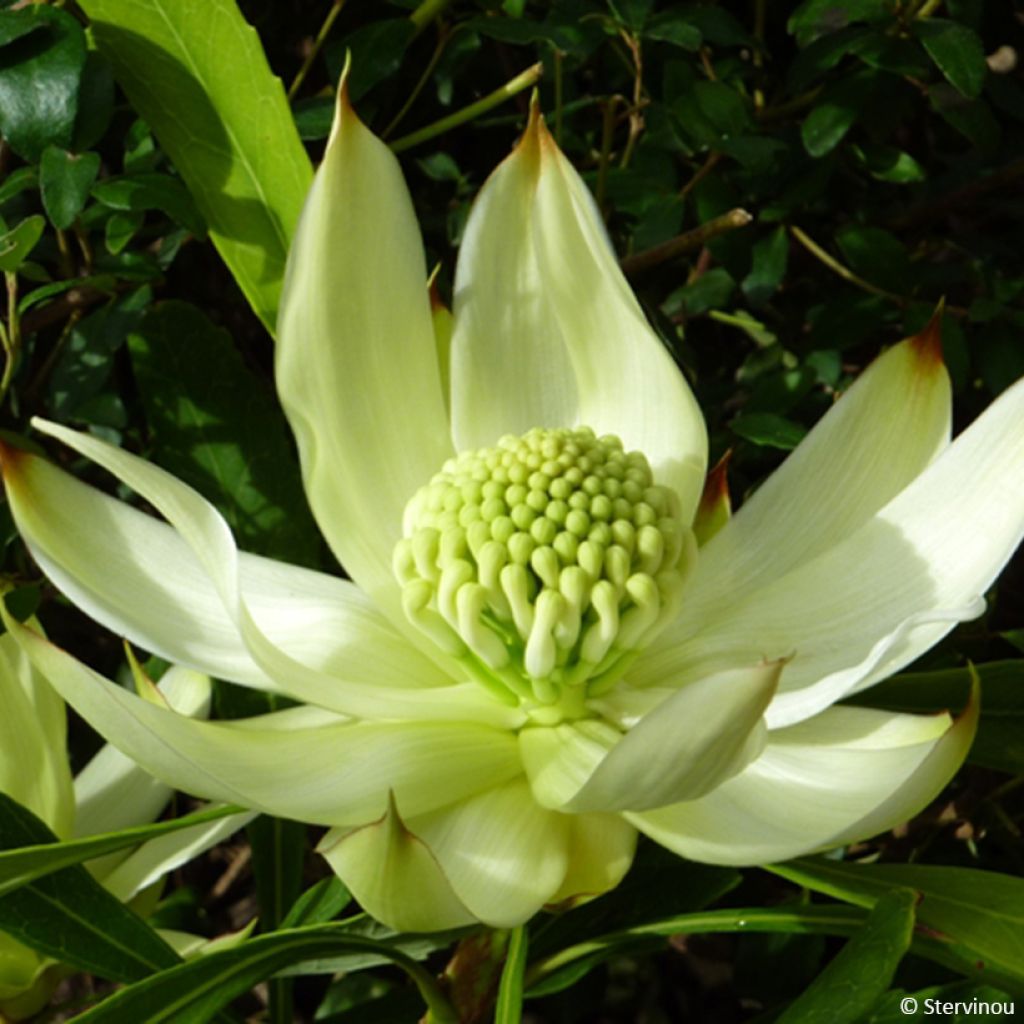

Telopea speciosissima White
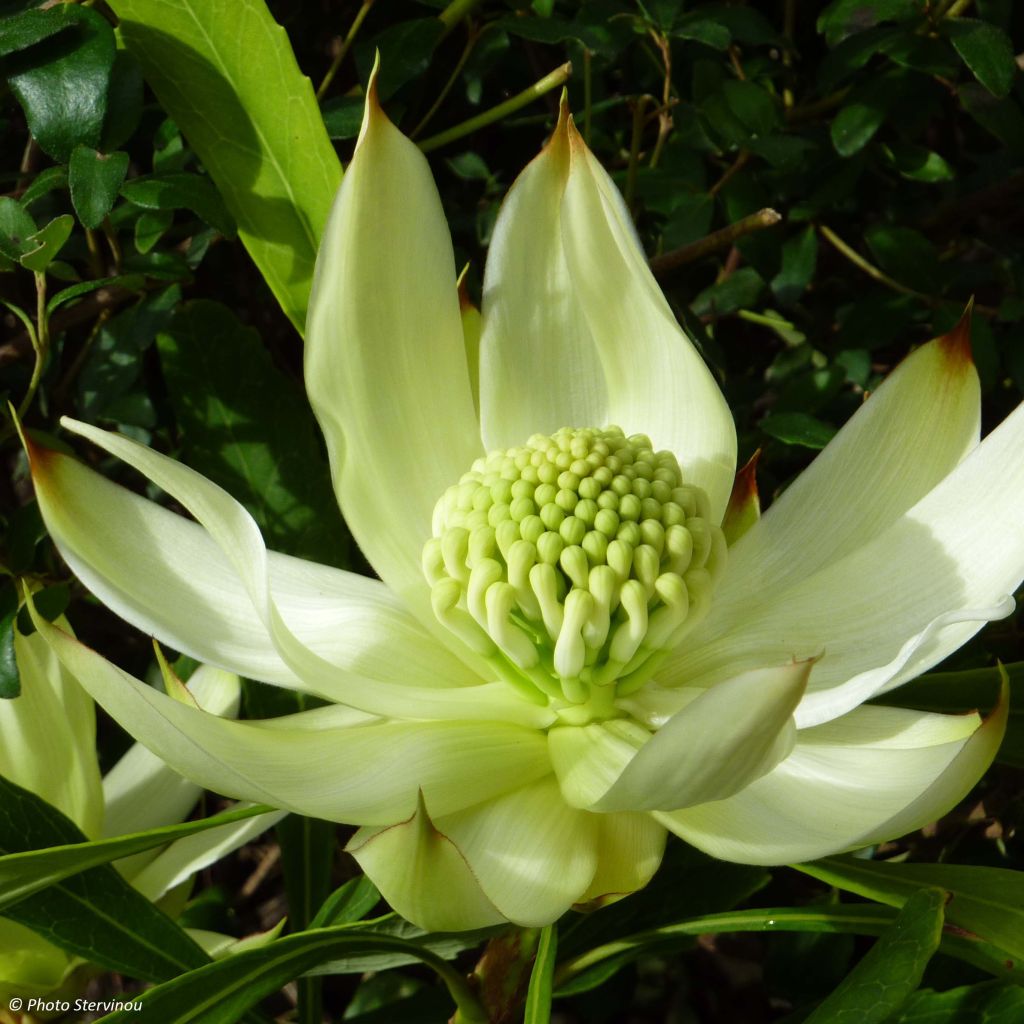

Telopea speciosissima White
Telopea speciosissima White
Telopea speciosissima White
Waratah
This item cannot be shipped to the selected country
Delivery charge from €5.90
More information
Schedule delivery date,
and select date in basket
This plant carries a 24 months recovery warranty
More information
We guarantee the quality of our plants for a full growing cycle, and will replace at our expense any plant that fails to recover under normal climatic and planting conditions.
From €5.90 for pickup delivery and €6.90 for home delivery
Express home delivery from €8.90.
Does this plant fit my garden?
Set up your Plantfit profile →
Description
The Telopea speciosissima 'White', covered with large white and globular inflorescences in spring, is less common in cultivation but just as spectacular as the classic Waratah with dark pink flowers. It is a rather well-adapted bush to our mild and moist coastal regions. Close to proteas, intensely exotic, it shares with them a marked preference for very well-drained, sandy soils devoid of limestone. Its tough foliage, a beautiful dark green, is decorative all year round, even when not in bloom.
The Telopea speciosissima, the floral emblem of New South Wales in Australia, belongs to the fascinating family of Proteaceae. It is native to the outskirts of Sydney where it is called Waratah. The southeast of Australia, much wetter than the west, has a climate similar to that of our mild oceanic regions, with slightly lower annual rainfall. It can be found growing in the dappled shade of Eucalyptus trees, on loamy and sandy soils, in lowland areas as well as up to 1000 m (3281ft) altitude. The Telopea is cultivated for cut flowers, but also in gardens for its ornamental qualities.
The 'White' selection differs only in the white coloration of its inflorescences. This woody and branched plant grows from a stump called a lignotuber, capable of producing shoots after fire or cold. Its habit is bushy, carried by upright branches. The in-ground bush reaches 3 m (10ft) in height and 2 m (7ft) in width under European climates in favorable conditions. At the age of 10, it will measure approximately 2 m (7ft) in height by 1.20 m. In a pot, its dimensions will be more modest. The leaves, alternate, erect, simple and tough, wedge-shaped, measuring 10 to 25 cm in length, are arranged spirally around the stem. They are dark green in color and regularly toothed along the edges. The Telopea produces its flower buds during winter, but its flowering occurs in spring, in May-June, at the ends of the branches. These are sumptuous flower heads in domes, 8 to 10 cm (3 to 4in) wide, composed of a dense core of up to 250 incurved tubular flowers, pure white, surrounded by bright bracts of the same color. The flowers are highly valued in floristry, due to their excellent vase life. On the plant, they can last almost 4 weeks. They contain abundant nectar and are pollinated by insects and birds. The large flat seeds will only form in the presence of at least two distinct individuals. After spring flowering, new shoots often emerge within the faded inflorescences. The Telopea is a very long-lived plant that can live for many years in the garden if it is happy.
The Telopea 'White' is a plant with a very exotic appearance that deserves to be grown. It will thrive in coastal gardens spared from severe frost, in very light, well-drained soil without limestone, and poor in nitrates and phosphorus. It prefers the climates of Brittany or Aquitaine to the Mediterranean, which is too dry in summer. This protea will be the pride of its happy owner, planted in isolation, on a large slope or in the background of flower beds, but always in a sheltered and sunny position. In a garden inspired by exoticism, it can be associated with cordylines, proteas, Isopogon or Leucadendron, with Canary Island viper's bugloss, modest palm trees, or Leptospermum. This bush also grows very well in a container or large pot, to adorn the terrace or balcony of an experienced amateur.
Report an error about the product description
Telopea speciosissima White in pictures
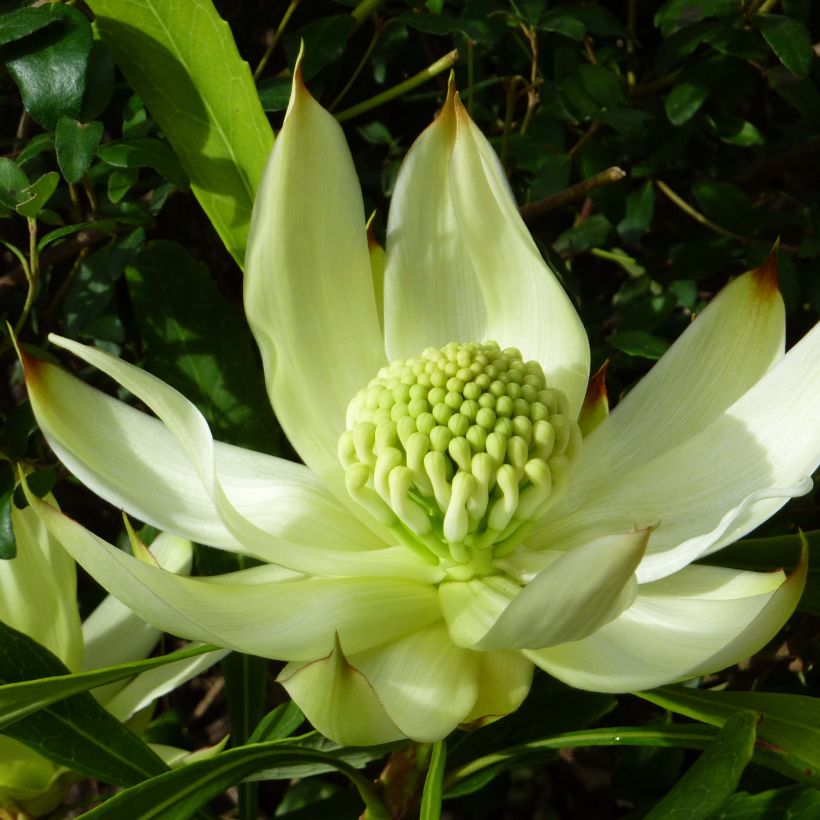

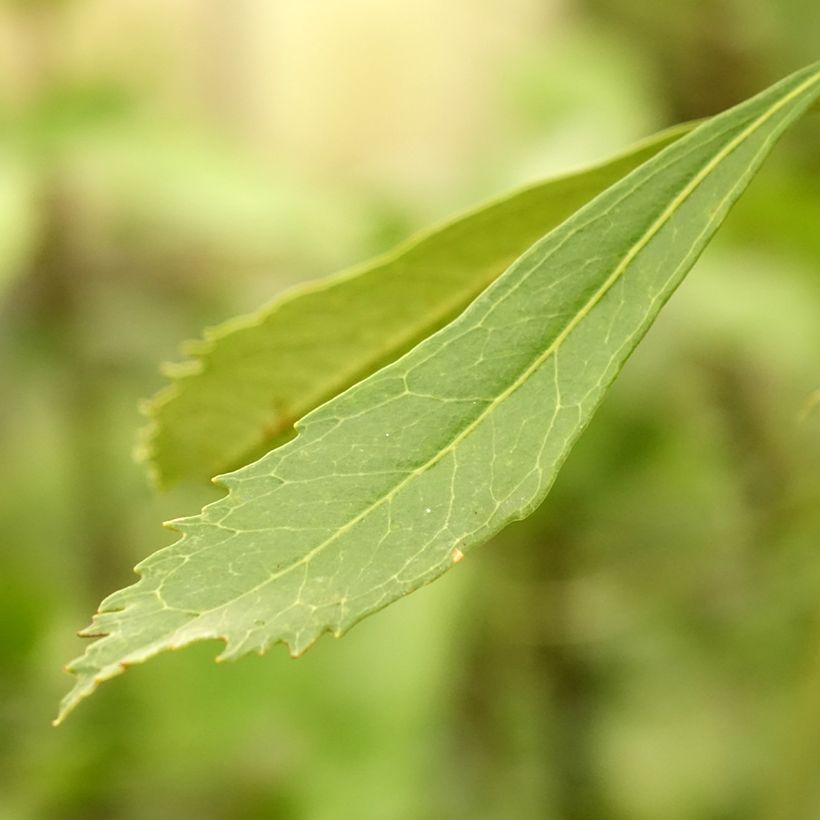

Plant habit
Flowering
Foliage
Botanical data
Telopea
speciosissima
White
Proteaceae
Waratah
Oceania
Other Waratah - Telopea
Planting and care
Plant the Telopea in a sunny but not scorching exposure (especially in the South), sheltered from cold winds, in a very well-drained soil, even sandy, without limestone, even very acidic. Immerse the root ball in a container of water for a few minutes. Remove the plant from its pot without disturbing the roots. Dig a wide and deep hole. Place the root ball on a very well-draining bed, composed of loose and light soil, leaf compost, ericaceous soil, and largely coarse sand or non-limestone gravel. Australian gardeners recommend draining the soil to almost a metre deep, or growing the plant in a container if this operation is impossible to do. Fill the hole with the same mixture. Water (with non-limestone water) to ensure proper compaction around the roots. This plant fears soils that are too rich and too wet in winter and summer, which cause root rot, but it needs water during the growing season, up to flowering, especially when grown in a pot. Do not use fertilizer, or only use a special protea amendment, low in nitrates and phosphates. Optionally prune after flowering to maintain a compact habit. In the ground, prefer mulching (with stones or pine bark) over weeding to prevent the appearance of weeds and spare the roots, which do not tolerate interventions with a hoe or garden claw.
Container cultivation will be done in a large perforated container (40 litres) filled with the same very well-draining mixture. Watering will be frequent, but not excessive. Do not place a saucer under your pot to avoid excess moisture at the root level, which is sensitive to fungal attacks. Fertilize with a protea fertilizer throughout the growing season, according to the manufacturer's instructions.
Planting period
Intended location
Care
-
, onOrder confirmed
Reply from on Promesse de fleurs
Evergreen shrubs
Haven't found what you were looking for?
Hardiness is the lowest winter temperature a plant can endure without suffering serious damage or even dying. However, hardiness is affected by location (a sheltered area, such as a patio), protection (winter cover) and soil type (hardiness is improved by well-drained soil).

Photo Sharing Terms & Conditions
In order to encourage gardeners to interact and share their experiences, Promesse de fleurs offers various media enabling content to be uploaded onto its Site - in particular via the ‘Photo sharing’ module.
The User agrees to refrain from:
- Posting any content that is illegal, prejudicial, insulting, racist, inciteful to hatred, revisionist, contrary to public decency, that infringes on privacy or on the privacy rights of third parties, in particular the publicity rights of persons and goods, intellectual property rights, or the right to privacy.
- Submitting content on behalf of a third party;
- Impersonate the identity of a third party and/or publish any personal information about a third party;
In general, the User undertakes to refrain from any unethical behaviour.
All Content (in particular text, comments, files, images, photos, videos, creative works, etc.), which may be subject to property or intellectual property rights, image or other private rights, shall remain the property of the User, subject to the limited rights granted by the terms of the licence granted by Promesse de fleurs as stated below. Users are at liberty to publish or not to publish such Content on the Site, notably via the ‘Photo Sharing’ facility, and accept that this Content shall be made public and freely accessible, notably on the Internet.
Users further acknowledge, undertake to have ,and guarantee that they hold all necessary rights and permissions to publish such material on the Site, in particular with regard to the legislation in force pertaining to any privacy, property, intellectual property, image, or contractual rights, or rights of any other nature. By publishing such Content on the Site, Users acknowledge accepting full liability as publishers of the Content within the meaning of the law, and grant Promesse de fleurs, free of charge, an inclusive, worldwide licence for the said Content for the entire duration of its publication, including all reproduction, representation, up/downloading, displaying, performing, transmission, and storage rights.
Users also grant permission for their name to be linked to the Content and accept that this link may not always be made available.
By engaging in posting material, Users consent to their Content becoming automatically accessible on the Internet, in particular on other sites and/or blogs and/or web pages of the Promesse de fleurs site, including in particular social pages and the Promesse de fleurs catalogue.
Users may secure the removal of entrusted content free of charge by issuing a simple request via our contact form.
The flowering period indicated on our website applies to countries and regions located in USDA zone 8 (France, the United Kingdom, Ireland, the Netherlands, etc.)
It will vary according to where you live:
- In zones 9 to 10 (Italy, Spain, Greece, etc.), flowering will occur about 2 to 4 weeks earlier.
- In zones 6 to 7 (Germany, Poland, Slovenia, and lower mountainous regions), flowering will be delayed by 2 to 3 weeks.
- In zone 5 (Central Europe, Scandinavia), blooming will be delayed by 3 to 5 weeks.
In temperate climates, pruning of spring-flowering shrubs (forsythia, spireas, etc.) should be done just after flowering.
Pruning of summer-flowering shrubs (Indian Lilac, Perovskia, etc.) can be done in winter or spring.
In cold regions as well as with frost-sensitive plants, avoid pruning too early when severe frosts may still occur.
The planting period indicated on our website applies to countries and regions located in USDA zone 8 (France, United Kingdom, Ireland, Netherlands).
It will vary according to where you live:
- In Mediterranean zones (Marseille, Madrid, Milan, etc.), autumn and winter are the best planting periods.
- In continental zones (Strasbourg, Munich, Vienna, etc.), delay planting by 2 to 3 weeks in spring and bring it forward by 2 to 4 weeks in autumn.
- In mountainous regions (the Alps, Pyrenees, Carpathians, etc.), it is best to plant in late spring (May-June) or late summer (August-September).
The harvesting period indicated on our website applies to countries and regions in USDA zone 8 (France, England, Ireland, the Netherlands).
In colder areas (Scandinavia, Poland, Austria...) fruit and vegetable harvests are likely to be delayed by 3-4 weeks.
In warmer areas (Italy, Spain, Greece, etc.), harvesting will probably take place earlier, depending on weather conditions.
The sowing periods indicated on our website apply to countries and regions within USDA Zone 8 (France, UK, Ireland, Netherlands).
In colder areas (Scandinavia, Poland, Austria...), delay any outdoor sowing by 3-4 weeks, or sow under glass.
In warmer climes (Italy, Spain, Greece, etc.), bring outdoor sowing forward by a few weeks.

































